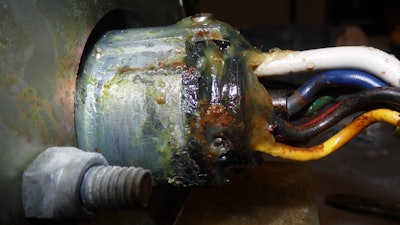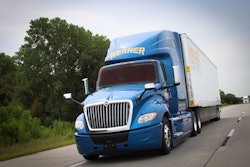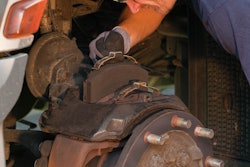
Winter weather can cause myriad problems for heavy-duty trucks. Among them is the start or worsening of corrosion to the wiring and electrical components along the undercarriage of the equipment.
Some electric wiring and components underneath the truck are more susceptible to corrosion than others. However, for service providers, there are ways they can help their customers by knowing how to help prevent corrosion, identify the start of it and take measures to stem the corrosion — as well as know when it’s too far along and wires and components need to be replaced.
Undercarriage electrical corrosion can be caused by many factors. The most common appears to be the chemicals used to deice roadways.
Phillips Industries says it has seen an increase in corrosion due to the usage of calcium and magnesium chloride.
“These chemicals are great for keeping ice from adhering to the road surface but creates havoc to the truck and trailer components. The molecular makeup of commonly used deicing chemicals is about 50 percent smaller than traditional road salt, meaning it's easier for them to fit into tighter spaces,” says Andrea Smeby, marketing content specialist, Phillips Industries.
What’s more, Smeby says these chemicals “are also hygroscopic, meaning they can pull moisture from relatively dry air, resulting in an accelerated corrosion process, even during the warmer months.”
 Truck-Lite
Truck-Lite
In addition to prolonged exposure to moisture, debris and today’s road salts, which will eventually compromise an electrical system that isn’t properly safeguarded, Andrew Liuzzo, marketing communications specialist, Truck-Lite, says corrosion can occur in warmer months, too.
“Vehicles in more humid climates can experience a compromised electrical system,” he says. “Ensuring a wiring system contains sealed connections and is free of any entry points for moisture and debris is the best way to protect against environmental variables from climate to climate.”
The main cause of corrosion is moisture intrusion into vulnerable systems, says Alicia Jones, global market manager, trailer/body builder, Grote Industries.
“Water, road spray, road salt and pre-treat chemicals are all corrosive elements that can enter the electrical system through any opening, unsealed connection or compromised barrier,” Jones says. “Once corrosive moisture has entered wires or cables, it will be drawn through the length of the wire via a capillary effect that pulls corrosion throughout the system.”
Chris Sterwerf, chief financial officer and chief operating officer, Fairfield Auto & Truck Service, says technician error has as much to do with undercarriage electrical corrosion as does moisture, road chemicals, etc.
“Things go wrong when a careless, untrained or pressed for time technician uses outdated practices for diagnosing and repairing electrical systems and creates opportunities for corrosion to set in. Overly aggressive pressure washing, … improper terminal tools and bad wire repairs are the usual suspects,” Sterwerf says.
He adds another opening for corrosion is when a technician doesn’t use the correct terminal pin removal tool to get a wire out of a terminal connection.
“Often, [technicians] go for the smallest sharpest tool they can find nearby that they can shove into the hole to work the pin out. This can damage the wire, pin or widen the plastic opening on the terminal and create another opportunity for water and electrolytes to find their way in,” Sterwerf says.
At risk for undercarriage corrosion
Certain undercarriage wiring and components are more susceptible to corrosion than others, say experts.
Smeby says while there tends to be a primary focus on the 7-way socket and plug maintenance, corrosion causing contaminants can easily creep into the electrical system through any open connection.
“Cable/wiring that is pierced or spliced into for testing or repairs, poorly sealed connectors and even loose lighting connections due to road vibration are open doors for unwanted corrosion,” she says. “And corrosion can happen fast. As the electrical system is powered and unpowered, wires heat up and expand. When wires cool and contract, they draw in the air around them, including moisture and contaminants like deicing chemicals.”
Any compromised or improperly sealed systems along the vehicle undercarriage are vulnerable to the encroachment of corrosion, Jones says. “Lights, trailer harnesses, wiring, cables, electrical connections and lift gate components all are frequently exposed to moisture and chemicals and should be regularly inspected for damage that could lead to corrosion,” she says.
 Truck-Lite
Truck-Lite
Corrosion most often starts at improper lighting and harness connections, and Truck-Lite recommends the use of sealed connectors with a secondary lock to ensure the connector is fully engaged and protected from road spray, Liuzzo adds.
Sterwerf says frame rails also are susceptible to corrosion.
“Some trucks were once outfitted with multiple frame rails to handle heavy loads. Rails were commonly 50,000 psi of tensile strength. Now it’s not uncommon to see rails with 140,000 psi of tensile strength because of changes in metallurgy,” he says. “These changes can make the rails stronger and can make one rail do the job of two. However in some cases, the corrosion resistance properties of the rails are lessened at the expense of strength. The stakes are raised higher now that there is only one rail that corrosion has to eat through to create a dangerous situation.”
Finding and assessing corrosion
Technicians can perform an inspection, looking for signs of corrosion and, once identified, can then make the determination of what can be done about it.
PennFleet Owner Jim Kolea suggests inspecting for visible oxidation or corrosion as well as looking for loose connectors and broken wires.
What’s more, Jones says undercarriage components should be inspected for rust, deformation and damage indicative of corrosion.
“Copper is the metal most commonly used as a conductor in wires and connectors. Copper corrodes into a powdery green or white substance. Iron-based components form brown or red rust as they deteriorate,” Jones says.
“Be careful to inspect areas where dissimilar metals may come into contact, as a galvanic reaction can result that can greatly increase corrosion,” she adds.
 Grote Industries
Grote Industries
“Corrosion may be visible when green buildup begins at an open connection, such as a lighting pigtail. However, most often its usually hiding and identified during voltage drop testing. Testing with a multimeter should always begin where the symptoms first appear, such as a flickering light, and then move up toward the front of the trailer 7-way connection, searching for the problem area,” she says.
Once corrosion is found, technicians should determine if the undercarriage corrosion can be cleaned or if wires and components need to be replaced.
Kolea says whether to fix or replace wiring and components depends on how soon in the process it is caught. If it is caught early, it can be contained. “Routine inspections and preventative maintenance go a long way especially in harsh conditions where deicers and road salt are used,” he says.
Once corrosion has entered wires or cables, the parts will need to be replaced, advises Jones. “The risk to systems compromised by corrosion are severe and can include improper current draw, overheating of system components, irregular electrical problems, malfunctioning components and total system failure,” she says.
Sterwerf agrees it’s a case by case basis. Some wiring harnesses must be completely replaced depending on the sensitive nature of what information is traveling across them. Some wiring can be repaired if done properly per OEM workshop manuals and recommended practices from American Trucking Associations’ Technology & Maintenance Council.
“Frame rails can be repaired if the corrosion has been removed and there has not been a significant loss to the thickness of the rail that would in any way reduce the strength of the rail,” Sterwerf says. “When repainted, it’s recommended to use a two-part, activated coating such as an epoxy primer and then a two-part topcoat.”
Maintaining the harness integrity depends on where corrosion is found and how much buildup has already accumulated and penetrated the wiring system, according to Smeby. Some connections can be cleaned or replaced to remove corrosion. However, if the problem is internal to the harness, the harness or affected harness module should be replaced.
“Do not attempt to cut, splice or repair a harness, as it almost always will lead to a future problem. The cost is almost always more expensive than replacing the harness, and replacement avoids potential future issues,” she says.
Reducing corrosion
One way service shops can mitigate undercarriage corrosion for their customers is to take preventative measures.
Many of the best prevention opportunities occur when the system is initially installed. Grote’s male pin lamps use solid, spun-brass and tin-plated terminals for maximum corrosion resistance, Jones says.
Additionally, Grote applies corrosion-preventative grease to all its lamps and female terminals on harnesses. Products that protect electrical connections such as Grote’s Crimp Solder & Seal Connectors or heat shrink tubing also play a large part in corrosion prevention, the company says.
Given the harsh environments commercial vehicles face, the use of sealed connectors, proper procedures for field repair and dielectric grease or spray are some of the best ways to avoid wiring issues, says Liuzzo.
 Grote Industries harness connection.
Grote Industries harness connection.
During routine maintenance, inspection, cleaning, repair and replacement can help avoid the pitfalls of corrosion in the electrical system. “Every six months, or more frequently in highly corrosive environments, use a plug and socket brush with electrical cleaner to clean 7-way connectors,” advises Phillips.
“After every cleaning, re-apply dielectric grease on plug and socket pins to keep corrosion at bay. When replacing pigtails, clean connections with electrical cleaner and apply new corrosion protective dielectric grease,” Smeby says.
“Inspect cables and wires for road hazard damage such as cracks, cuts, rubbing or excessive butt connectors from an old repair. Replace or repair any damaged areas. If you must repair any part of the wiring harnesses, use heat shrink terminals or heat shrink tubing with adhesive that seals the connection. Consider using clear heat shrink products to ensure a perfect connection visibly,” she adds.
Phillips suggests a STA-DRY modular sealed harness that features the QCS2, a non-corrosive molded 7-way boot with a bulleted nylon socket, and harness connections with moisture blocking features such as triple interlocking ridges and wiper seals to keep contaminants out.
“The next important item is a preventative maintenance program. Maintaining a vehicle's electrical system all year long means less worry as the winter months approach, making sure it's ready for the wet weather,” Smeby says.














